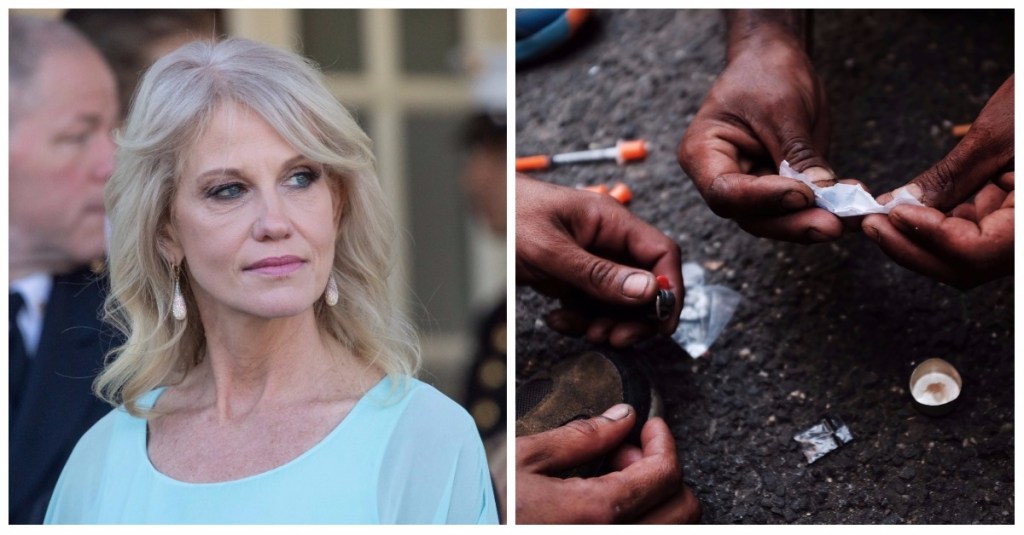It’s become an almost daily routine: Some panel, discussion, summit, commission, hearing, project, or report claims to have the answer to America’s historically deadly opioid crisis. The latest pathetic “solution,” of course, is the (weirdly disputed) emergence of longtime Republican pollster, Donald Trump “alternative facts” adviser, and noted public health expert Kellyanne Conway as some kind of alleged “opioid czar.” I say alleged because even though Attorney General Jeff Sessions suggested last week that she had the gig, the White House later said she was merely continuing existing work on the issue.
Who’s telling the truth? No fucking clue—and it doesn’t really matter. The time for talk is over. In the past three years alone, more than 100,000 Americans have died of opioid overdose. Mothers, fathers, sisters, brothers, children—a tremendous loss. Conway is close to President Trump and this news has been taken by some as a signal that he’s finally serious about addressing opioids. But what does that even mean when no new money is being appropriated, healthcare cuts may be on the way, and no actual “drug czar” has been named to coordinate strategy, among other glaring gaps in the administration’s response to this disaster?
Videos by VICE
To genuinely get serious about stopping the bleeding, America needs a new coalition. Advocates for people with addiction and people with pain need to put aside their fears and differences and form a united front to force whoever turns out to be in charge to pay attention. After all, we know what needs to be done, and when we start treating both addiction and pain humanely based on evidence, everyone wins.
First and foremost, we need to make it easier and cheaper to get treatment for addiction with buprenorphine or methadone than it is to buy heroin—or at least give treatment a fighting chance at competing with dealers. Being on these medications cuts the death rate by 50 percent or more, according to numerous studies, and it’s the only approach proven to do so. Get more of these medications to those who need them and we’ll have fewer deaths. It’s really that simple.
Whenever someone is caught “doctor shopping” or inappropriately trying to get opioids—and whenever anyone who has opioid addiction seeks help—they should have immediate access to these medications and alternatives like long-acting naltrexone (Vivitrol) as appropriate, with treatment tailored to the patient’s needs and goals.
FDA director Scott Gottlieb seems to understand the medication issue: He gets this isn’t simply replacing one addiction with another, but providing care that allows people to return to function or at least avoid dying. But he, the Department of Health and Human Services, and Congress need to be pressured to remove cumbersome regulations like special requirements for buprenorphine prescribing and limits on methadone use outside of clinics.
The rules of the public health emergency that has already been declared by the Trump administration might allow this if people like Gottlieb felt empowered to use them—and we have tons of data showing it would help. France, for example, responded to an overdose crisis by allowing all physicians to prescribe buprenorphine without restrictions or special training: Overdose deaths dropped by 75 percent within four years.
For expanded medication access to be most effective, doctors need to be able to prescribe simply as harm reduction—without requiring abstinence or counseling. These and other services that are often helpful shouldn’t be forced on all, but triaged to those who actually want them. This would not only cut costs, but improve both quality (group therapy is better when the people who are in it aren’t just sitting and waiting it out or rolling their eyes at those who try to participate) and outcomes. Law enforcement will need to be educated that prescribing to those who are not yet ready to recover is not criminal, but vital.
Under current law, we could—as cities like New York have in the past—rapidly expand access to maintenance medications. But we need hospitals and emergency rooms to step up and provide it. We need primary care docs, physician’s assistants, and telemedicine, all pulling together. The old rules aren’t just not working—they’ve become deadly. And easy access to maintenance medications will help people in pain, too, by reducing the need for anyone to lie to doctors to get drugs and making the doctor/patient relationship less fraught.
For pain patients, the most critical need is to stop the current assault on those who are already on opioids, particularly attempts to lower dosages without regard to individual circumstances or choices. The forced tapering or outright abandonment of any kind of patient to the tender mercies of the illegal market is associated with more deaths, not fewer.
Consequently, when “pill mills” are busted or doctors stop prescribing for any other reason, every single patient—regardless of their medical condition—needs continuity of care and the ability to make informed choices about their medical future. The DEA, medical boards and attorneys general must be held accountable for what happens to patients—including people with addiction—when they crack down on doctors. Typically, they are left to fend for themselves, without even a referral. This must end.
Doctors seem to have already become far more cautious about prescribing for acute pain—and limited prescribing for chronic pain to those for whom other approaches have failed. Now we need to make sure these limits aren’t harming those who do benefit from opioids.
Marijuana legalization can also help: Nearly a dozen studies now show that medical marijuana is associated with a reduction in use of opioids for both pain and for addiction, as well as a reduction in overdose deaths. The government should also leave other, less harmful substitutes like Kratom alone.
Of course, cheap naloxone needs to be more available to reverse overdoses, safe injection facilities should be approved, drug checking to determine if fentanyl is present should be accessible—all of this needs to be done, too. But the strategy most likely to save the most lives most quickly is to rapidly expand maintenance and stop pushing people out of medical care, even if they misuse drugs.
And, in the long term, we have to decriminalize possession of all drugs and shift the money spent locking people in cages and increasing their risk of overdose death over to providing compassionate, evidence-based treatment.
America’s current system of coercive, demanding and often demeaning care itself creates resistance to treatment. When people see getting help as well, helpful, they seek it, because—believe it or not—active addiction isn’t fun. Heroin prescribing—which has been shown to not only reduce crime and disease but also increase employment—is another example of a harm-reduction approach that should be added to the menu.
Regular readers, of course, will not be surprised by this list: It sums up much of what I’ve covered in this column over the past few years. To genuine opioid experts, little here is even controversial—certainly not expanding maintenance. In the endless meetings Conway sat through during her work on the president’s opioid commission, she’s almost certainly become familiar with this data, too. What’s missing is a united coalition to push her and others who have the power to finally make it happen.
Follow Maia Szalavitz on Twitter.
More
From VICE
-

Photo: Ryan Young / Cornell University -

Photo: Eetum / Getty Images -

Photo: Lajst / Getty Images -

Photo: The Good Brigade / Getty Images
